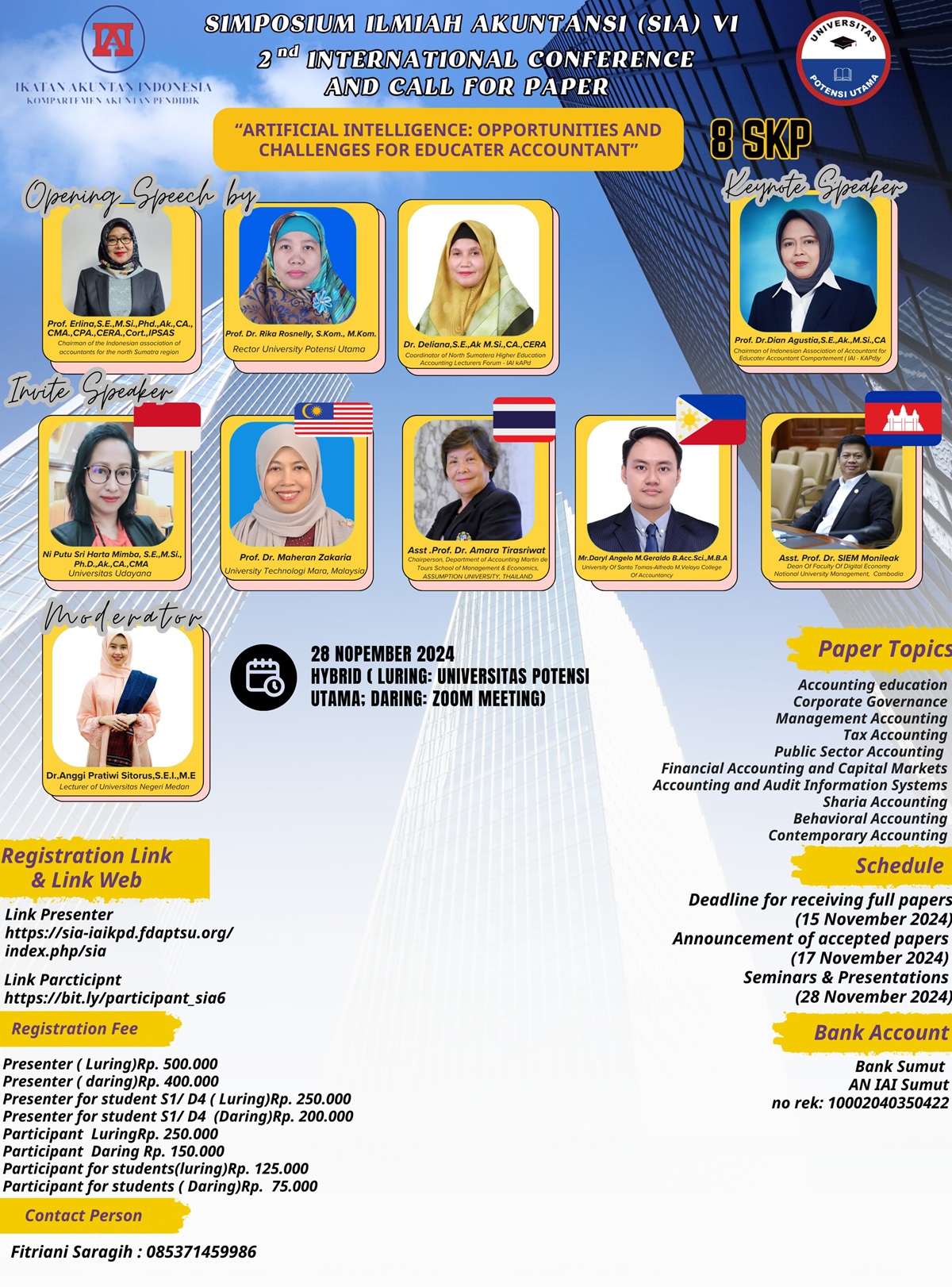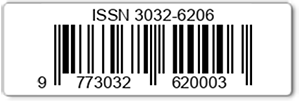Auditor's Intention To Adopt Computer-Assisted Audit Techniques (CAATs) In Performing Audit Tasks
Keywords:
Adoption, CAATs, Intention, TAM, TPBAbstract
Computer-Assisted Audit Techniques (CAATs) have become an integral tool in modern auditing practices, offering numerous advantages in terms of efficiency, accuracy, and the ability to analyze vast amounts of data. However, the adoption of CAATs among auditors has been uneven. This conceptual paper explores the factors influencing auditors' intention to adopt CAATs in their audit tasks. Drawing upon established theories such as the Technology Acceptance Model (TAM) and the Theory of Planned Behavior (TPB), the paper examines the role of perceived usefulness, perceived ease of use, subjective norms, and perceived behavioral control that drive or hinder the adoption of CAATs. This paper also discusses the challenges and opportunities presented by CAATs and offers recommendations for fostering their broader adoption in the auditing profession.
References
Abeysiri Munasinghege, L., & Perumbuli Mudalige, D. M. (2024). Audit software (CAAT) and audit quality: A qualitative study regarding impact audit software and audit quality in Sri Lankan context. Available at https://www.diva-portal.org/smash/record.jsf?pid=diva2%3A1871019&dswid=-5940
Ajzen, I. (1991). The theory of planned behavior. Organizational Behavior and Human Decision Processes, 50(2), 179-211.
Al-Ateeq, B., Sawan, N., Al-Hajaya, K., Altarawneh, M., & Al-Makhadmeh, A. (2022). Big data analytics in auditing and the consequences for audit quality: A study using the technology acceptance model (TAM). Corporate Governance and Organizational Behavior Review, 6(1), 64–78. https://doi.org/10.22495/cgobrv6i1p5
Almagrashi, A., Mujalli, A., & Khan, T. (2023). Factors determining internal auditors’ behavioral intention to use computer-assisted auditing techniques: An extension of the UTAUT model and an empirical study. Future Business Journal, 9 (74). https://doi.org/10.1186/s43093-023-00231-2
Al Omari, H. M. A., Kadir, M. R. A., Sapingi, R. B., & Al-Dalaien, A. (2025). The dynamics of CAATs adoption in Jordan: Bridging top management support with auditor innovativeness and IT competency. WSEAS Transactions on Business and Economics, 22, 20-31. https://wseas.com/journals/articles.php?id=9585
Atta, A., Baniata, H., Othman, O., Ali, B., Abughaush, S., Aljundi, N., & Ahmad, A. (2024). The impact of computer assisted auditing techniques in the audit process: An assessment of performance and effort expectancy. International Journal of Data and Network Science, 8(2), 977-988. http://dx.doi.org/10.5267/j.ijdns.2023.12.009
Davis, F. D. (1989). Perceived usefulness, perceived ease of use, and user acceptance of information technology. MIS Quarterly, 13(3), 319-340.
Daoud, L. (2023). Predictors of auditors’ usage of CAATs: The role of top management support and trust. Information Sciences Letters, 12(5), 1841-1850. Available at: https://digitalcommons.aaru.edu.jo/isl/vol12/iss5/28
Doganay, D. (2019). Identifying factors affecting auditors’ adoption of computer assisted audit tools and techniques (CAATTs): an empirical investigation (Master's thesis, Middle East Technical University). http://etd.lib.metu.edu.tr/upload/12625070/index.pdf
Fortinet. (2023). Data security: Definition, importance, and types. Retrieved from https://www.fortinet.com/resources/cyberglossary/data-security
Khan, H. (2024). The vital role of data security, privacy, and internal audits. Retrieved from https://www.grassiadvisors.com/blog/safeguarding-customer-data-the-vital-role-of-data-security-privacy-and-internal-audits/
Handoko, B. L., & Suryadharma, W. (2020, December). Planned Behavior and Social Cognitive Model on Auditor's Attitude in Adopting Information Technology. In Proceedings of the 2020 2nd International Conference on E-Business and E-commerce Engineering (pp. 35-43). https://doi.org/10.1109/ICCED60214.2023.10425437
Kumari, J. S., Senani, K. G. P., & Ajward, R. (2024). Examining determinants of auditors’ intention to use CAATs in external auditing using an extended UTAUT model; evidence from Sri Lanka. Journal of Financial Reporting and Accounting. https://doi.org/10.1108/JFRA-08-2023-0474
Medha, M. H., Nahid, M. H., & Naadia, M. (2023). Adoption of audit management system within audit farms in Bangladesh. Indonesia Auditing Research Journal, 12(3), 116-133. https://doi.org/10.35335/arj.v12i3.197
Mustika, J., Karlina, L., & Tirta, B. D. (2023, February). Using the UTAUT model to analyze perception of independent auditor on usage of Computer Assisted Audit Techniques. In Proceeding Medan International Conference on Economic and Business (Vol. 1, pp. 629-637). https://doi.org/10.30596/miceb.v1i0.168
Pedrosa, I., Costa, C. J., & Aparicio, M. (2020). Determinants adoption of computer-assisted auditing tools (CAATs). Cognition, Technology & Work, 22, 565-583. https://doi.org/10.1007/s10111-019-00581-4
Senan, N. A. M. (2024). Influential factors shaping the adoption and utilization of audit technology (CAATS) in the audit practices in Saudi Arabia: Human capital expertise as a moderating factor. Uncertain Supply Chain Management, 12, 2607–2618, http://dx.doi.org/10.5267/j.uscm.2024.5.009
Siew, E. G., Rosli, K., & Yeow, P. H. (2020). Organizational and environmental influences in the adoption of computer-assisted audit tools and techniques (CAATTs) by audit firms in Malaysia. International journal of accounting information systems, 36, 100445. https://doi.org/10.1016/j.accinf.2019.100445
Stone, M. (2023). Computer assisted audit techniques (CAATs): Definition & uses. Study.com. Retrieved from https://study.com/academy/lesson/what-are-caats-definition-use.html
Susanto, H., Pramono, A. J., Akbar, B., & Suwarno, S. (2023). The adoption and readiness of digital technologies among auditors in public accounting firms: A structural equation modeling analysis. Research Horizon, 3(2), 71–85. https://doi.org/10.54518/rh.3.2.2023.71-85
Vitali, S., & Giuliani, M. (2024). Emerging digital technologies and auditing firms: Opportunities and challenges. International Journal of Accounting Information Systems, 53, 100676. https://doi.org/10.1016/j.accinf.2024.100676
Wijerathna, J. M. K. G. T. G. (2024). The Impact of Organizational Factors and Environmental Factors on the Adoption of Computer Assisted Audit Tools and Techniques (CAATTs) by SME in Sri Lanka. Wayamba Journal of Management, 15(1). https://doi.org/10.4038/wjm.v15i1.7615
Downloads
Published
Issue
Section
License
Copyright (c) 2024 WAN NORASWANIATY WAN AHMAD, PROFESSOR DR. MAHERAN ZAKARIA (Author)

This work is licensed under a Creative Commons Attribution 4.0 International License.
Simposium Ilmiah Akuntansi under the terms of a Creative Commons Attribution 4.0 International License / CC BY 4.0 This license permits anyone to copy and redistribute this material in any form or format, compose, modify, and make derivative works of this material for any purpose, including commercial purposes, so long as they include credit to the Author of the original work.











